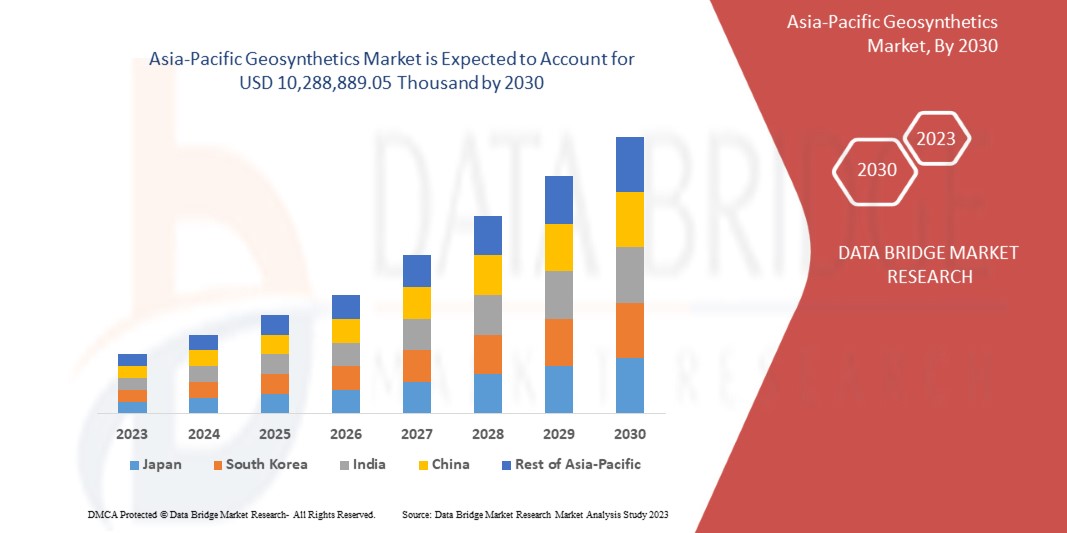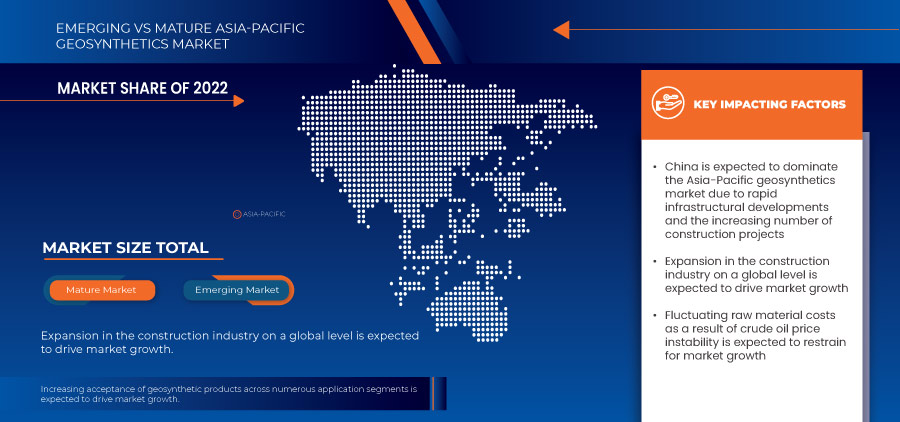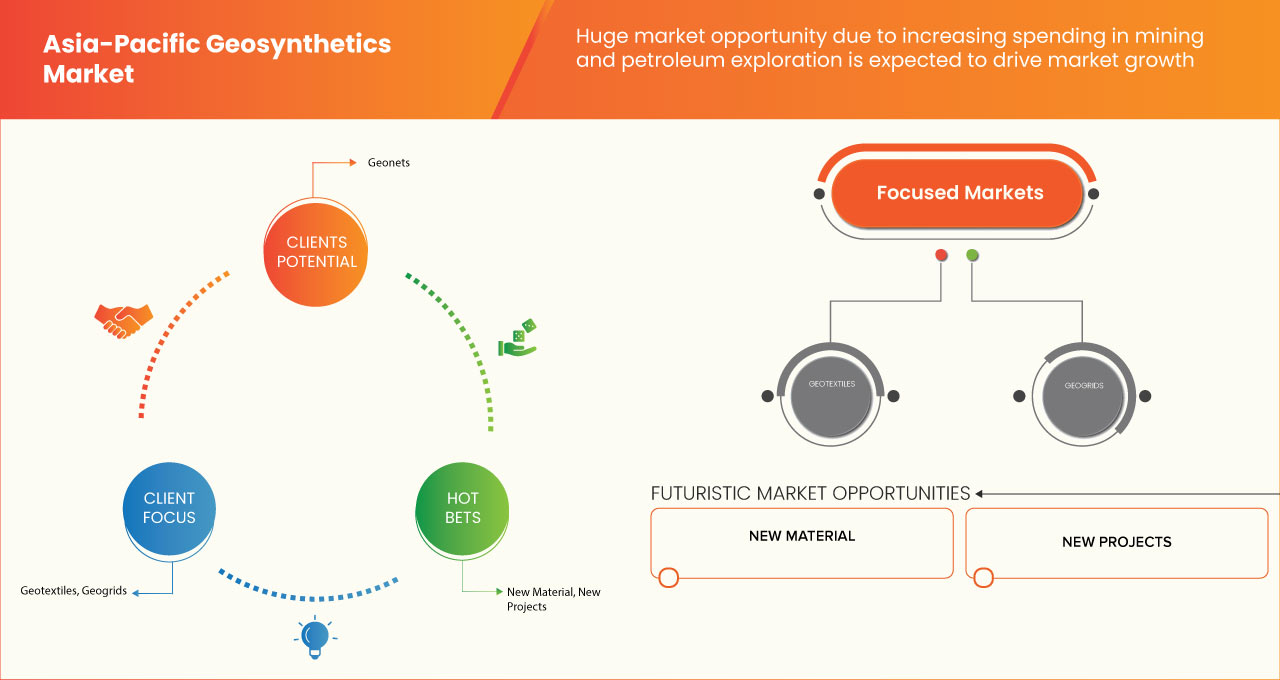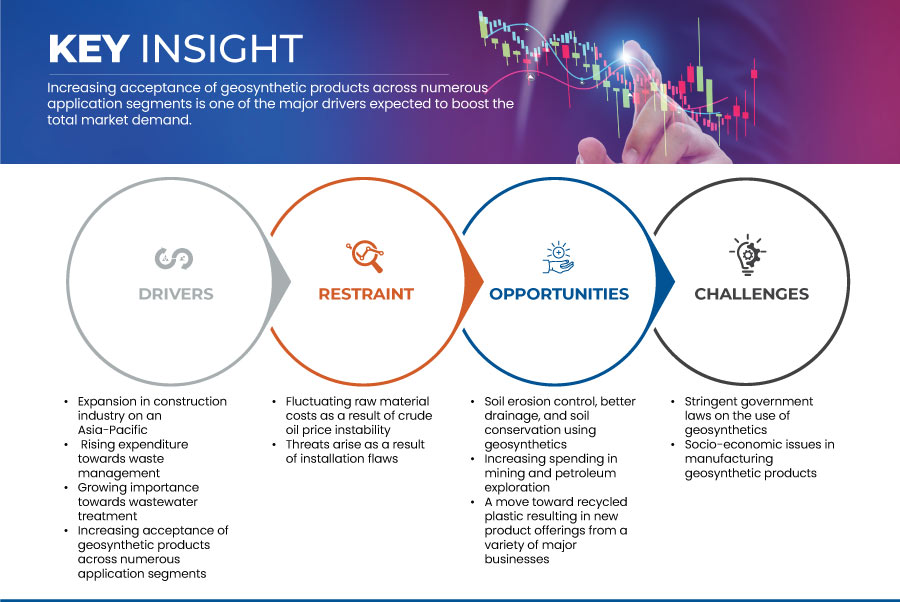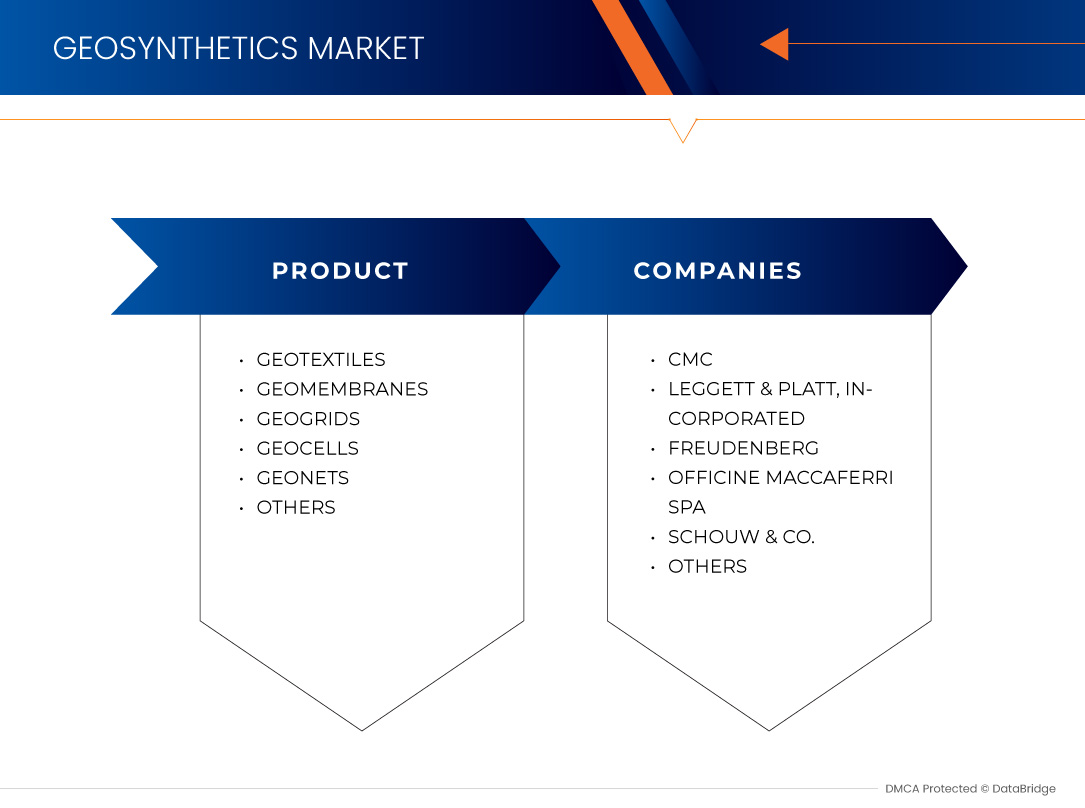Asia Pacific Geosynthetics Market
Market Size in USD Thousand
CAGR :
% 
 USD
6,373,698.47 Thousand
USD
10,288,889.05 Thousand
2022
2030
USD
6,373,698.47 Thousand
USD
10,288,889.05 Thousand
2022
2030
| 2023 –2030 | |
| USD 6,373,698.47 Thousand | |
| USD 10,288,889.05 Thousand | |
|
|
|
Asia-Pacific Geosynthetics Market, By Product (Geotextiles, Geomembranes, Geogrids, Geocells, Geonets, and Others) - Industry Trends and Forecast to 2030.
Asia-Pacific Geosynthetics Market Analysis and Insights
Expansion in the construction industry in Asia-Pacific is acting as a major driver for market growth. In addition, rising spending towards waste management, the growing importance of wastewater treatment, and increasing acceptance of geosynthetic products across numerous application segments are expected to propel market growth. The major restraints that may negatively impact the market are fluctuating raw material costs as a result of crude oil price instability and threats arising as a result of installation flaws. Soil erosion control, better drainage, and soil conservation using geosynthetics are expected to provide opportunities for market growth. However, stringent government laws on the use of geosynthetics are expected to act as a challenge to market growth.
Data Bridge Market Research analyzes that the Asia-Pacific geosynthetics market is expected to reach USD 10,288,889.05 thousand by 2030 from USD 6,373,698.47 thousand in 2022, growing at a CAGR of 6.2% during the forecast period of 2023 to 2030.
|
Report Metric |
Details |
|
Forecast Period |
2023 to 2030 |
|
Base Year |
2022 |
|
Historic Years |
2021 (Customizable to 2015 - 2020) |
|
Quantitative Units |
Revenue in USD Thousand |
|
Segments Covered |
Product (Geotextiles, Geomembranes, Geogrids, Geocells, Geonets, and Others) |
|
Countries Covered |
China, Japan, South Korea, India, Singapore, Vietnam, Thailand, Indonesia, Malaysia, Philippines, Australia, New Zealand, Taiwan and Rest of Asia-Pacific |
|
Market Players Covered |
CMC, Leggett & Platt, Incorporated, Berry Global, Inc., Global Synthetics, HUESKER, Agru America Inc., SKAPS Industries, Glen Raven Inc., SOLMAX, Schouw & Co., Naue Gmbh & Co.KG, Officine Maccaferri Spa, PRS Geo-Technologies, and Freudenberg are among others |
Market Definition
Geosynthetics refers to the polymers that are employed in civil engineering, construction, and related applications. These are generally used to stabilize the terrains and exhibit high durability that complements the other building materials. The different types of geosynthetics involve geotextile, geomembrane, geo-composite, and geosynthetic liner among others. Apart from civil engineering and construction, these are also used in transportation and hydraulic applications. They are typically made from synthetic materials such as PVC, polyethylene, or polypropylene, which when properly embedded, can help contribute to soil stabilization and prevent erosion.
Asia-Pacific Geosynthetics Market Dynamics
Drivers
- Expansion in Construction Industry on an Asia-Pacific
Geosynthetics of various sorts are employed in civil engineering and building projects. Depleting sources of granular and other basic raw materials, along with restricted project funding, have created new chances for inventive engineering to provide cost-effective solutions. One of these breakthroughs is the use of geosynthetics into civil engineering. Geosynthetics are recognized as genuine engineering materials that not only substitute for limited raw resources such as cement and steel, but are also proving to be a fairly solid and good alternative to traditional designs.
This growth in the construction industry increases demand for geosynthetic goods such as geotextiles, geogrids, geonets, geomembranes, Geosynthetic Clay Liner (GCL), geocells, geocomposites, geopipes, and geofoams, which is expected to drive market growth. Geotextiles and geogrid are used to improve the performance of permanent roads or to lower their thickness.
- Rising Expenditure Toward Waste Management
Rapid urbanization and a quickly growing Asia-Pacific population both contribute to increased amounts of liquid and solid waste. Growing environmental consciousness is increasing the demand for projects that correctly handle water and waste. Geosynthetics operate as smart products as waste containment and management solutions in an effort to safeguard the environment from dangerous industrial wastes. Landfill gases and leachate should ideally be managed in a way that preserves the environment.
Geosynthetics are used in waste management for landfill liner solutions, leachate drainage, gas collection, and dewatering systems. Geomembranes operate as liquid and landfill gas barriers, and GCL is used for landfill liner. Geonets, geotubes, and geocomposites are low-cost leachate drainage alternatives. These heavy-duty geosynthetics can endure high flow rates, are simple to install, and can sustain vertical loading. Biaxial geonets in gas collecting systems swiftly transport the gas to the site of treatment. geotubes, also known as dewatering tubes, are essential in any waste management operation.
Growing Importance towards Wastewater Treatment
Geosynthetics are frequently employed in a variety of water management operations due to the growing public concern over significant and widespread water contamination. They are also utilized to line holding ponds for shrimp and fish in big aquaculture operations. Lined ponds provide several advantages over traditional dirt or clay-lined ponds, including lower permeability and ease of cleaning and harvesting. The low permeability membranes keep more water in the ponds. It also ensures that illness, if it occurs, does not spread through the subsurface soils and infect nearby ponds.
Geosynthetics are effectively employed in a variety of applications to enhance the process of storing and treating water and wastewater. They have lower penetrable qualities and are often less costly, resulting in a wide range of uses such as aesthetic ponds, potable water storage, and wastewater treatment lagoons. Regardless of the purpose for lining a pond, the usage of geosynthetics in these applications is increasing. Geomembranes provide an almost impenetrable barrier, preventing any liquid in the pond from moving to the subsurface. Geonets, geocomposites, geotextiles, and geogrids can be used to vent gases, cushion against uneven subgrade, and strengthen structures as needed.
- Increasing Acceptance of Geosynthetic Products Across Numerous Application Segments
Geosynthetics have a wide range of uses. It is nearly hard to find a significant infrastructure project that does not include the use of some form of geosynthetic component. This is why geosynthetics are a distinct type of materials. They provide a variety of roles ranging from chemical containment to soil structural reinforcement, and many more in between such as drainage, material separation, and filtering. These are the most important geosynthetic uses.
A containment application is any application that uses geosynthetics as a barrier to liquid or gas materials. Heap leach mining liners, wastewater management, secondary tank containment, and landfill leachate liners are a few examples. The most typical geosynthetics for containment applications are clay liners, geocomposites, and geomembranes.
Geosynthetics in drainage applications remove subsurface or surface water from a given location. They serve a twofold purpose: first, they keep fine soil grains from clogging drainage systems, and second, they reinforce and maintain the structure's integrity. Dams, tunnels, pavement and roads, subsurface drainage, and erosion control all use geomembranes, geotextiles, and geogrids.
Filtration geosynthetics layers are used in most civil engineering applications to remove and separate moisture or fine particles from a structure. Geosynthetics such as geomembranes and geotextiles are widely acknowledged to provide superior filtration. They offer solutions for building airfields, roadways, and sports courts.
As a result, geosynthetics are frequently employed in the above-described applications. Furthermore, growing industrialization and an increase in the number of large infrastructure and environmental projects are moving the geosynthetics market forward.
Opportunities
- Soil Erosion Control, Better Drainage, and Soil Conservation using Geosynthetics
Soil erosion is considered as a regular occurrence as the natural development rate of soil has been quite sluggish in recent years. Therefore, it is recommended to use the best solution to artificially prevent soil erosion. Erosion management is also required to provide stability to other buildings against landslides, among other things, and it is also required to save the planets and soil formations from failing due to rain, gravity, or a variety of other factors. Geosynthetics are used to "block or limit soil or other particle motions at the surface of, for instance, a slope" in surface soil erosion management.
River banks are protected by geotextiles against erosion caused by currents or lapping. They function as a filter when combined with natural or artificial enrockments. Geotextiles used for erosion control can be woven or nonwoven. Woven textiles are suitable in soils with bigger particle sizes because they have greater pores. Nonwovens are employed in areas where soils such as clay silt develop. When hydraulic uplift is predicted, these materials must have a high permeability.
Geotextiles are used for drainage, erosion management, and cost-effective ground modification, geogrids are generally used for soil and aggregate reinforcing, geomembranes are used for separation of soil and fluid, improving soil shear strength, and geocomposites/geoweb are used in drainage.
- Increasing Spending in Mining and Petroleum Exploration
Geomembranes are more usually employed in mining applications such as heap leach facilities, evaporation ponds, and tailings impoundments, where normally very high loads occur. High Density Polyethylene (HDPE), Polyvinyl Chloride (PVC), Polypropylene (PP), and other materials are common raw materials for geomembranes. However, because of their superior chemical resistance and physical qualities, HDPE geomembranes are the most commonly utilized. Other design considerations must be considered in addition to the geomembranes' qualities, such as the influence of high stresses, the kind of foundation, and the material put beneath and on top of the geomembranes. The mining industry consumes around 40% of worldwide geomembranes output. In addition, firms in the mining sector provide and manufacture numerous geomembrane systems.
Restraints/Challenges
- Stringent Government Laws on the Use of Geosynthetics
Geosynthetics is a hot topic these days since they are finding a larger range of uses. Geosynthetic goods are less hazardous to the environment. Specific issues such as how they are made, handled, and installed, and the difficulties that geosynthetic materials may generate, must also be considered. Each government or nation throughout the world has developed strict regulations, guidelines, and criteria for their controlled usage without causing any harm or damage to the environment or in other sorts of key applications where geosynthetics are frequently employed.
- Socio-Economic Issues in Manufacturing Geosynthetic Products
Geosynthetic making has several challenges. The supply chain, labor problems, growing energy prices, quality improvements, keeping competitive, and sustainability are among the primary issues.
The progressive removal of COVID limitations in 2022 increased demand, exacerbating pandemic-related supply chain concerns with maritime freight and polymer resins. As a result, businesses must get items from local, SME-sized manufacturing plants. With sustained geopolitical stability causing a sovereign risk migration to domestic supply chains, the market looks to perceive this change as somewhat permanent and not cyclical.
There is also a growing inflationary cost disparity between nations with industrial competence. When compared to China's inflation rate of 2%, European countries (Spain, France, Germany, and Italy) have interest rates ranging from 6.2% to 9.2%, Australia has 7.8%, and the U.S. has 6.4%. As a result, rising energy costs provide a point of arbitrage between various manufacturing zones. With an expected increase in upstream crude oil and feedstock polyethylene, production costs will rise accordingly, affecting the final pricing of HDPE-based geosynthetics.
Improved quality leads to increased customer satisfaction, less waste, and lower total costs. Continuous geomembrane production without specified maintenance shutdowns for cleaning barrels and screws, on the other hand, might result in gels and burned resin inclusion problems. If this occurs, the investment in plant maintenance would have more than quadrupled. As a result, quality control should be improved in order to limit the amount of rejection.
Asia-Pacific Geosynthetics Market Scope
The Asia-Pacific geosynthetics market is segmented into a single notable segment based on product. The growth amongst these segments will help you analyze major growth segments in the industries and provide the users with a valuable market overview and market insights to make strategic decisions to identify core market applications.
Product
- Geotextiles
- Geomembranes
- Geogrids
- Geocells
- Geonets
- Others
On the basis of product, the market is segmented into geotextiles, geomembranes, geogrids, geocells, geonets, and others.
Asia-Pacific Geosynthetics Market Regional Analysis/Insights
The Asia-Pacific geosynthetics market is segmented into single notable segment based on product.
The countries covered in this market report are China, Japan, South Korea, India, Singapore, Vietnam, Thailand, Indonesia, Malaysia, Philippines, Australia, New Zealand, Taiwan and Rest of Asia-Pacific.
China is expected to dominate the Asia-Pacific geosynthetics market due to rapid infrastructural developments and the increasing number of construction projects.
The country section of the report also provides individual market-impacting factors and changes in market regulation that impact the current and future trends of the market. Data points downstream and upstream value chain analysis, technical trends, porter's five forces analysis, and case studies are some of the pointers used to forecast the market scenario for individual countries. Also, the presence and availability of new brands and their challenges faced due to large or scarce competition from regional brands, the impact of domestic tariffs, and trade routes are considered while providing forecast analysis of the country data.
Competitive Landscape and Asia-Pacific Geosynthetics Market Share Analysis
The Asia-Pacific geosynthetics market competitive landscape provides details by competitors. Details included are company overview, company financials, revenue generated, market potential, investment in research and development, new market initiatives, production sites and facilities, company strengths and weaknesses, product launch, product approvals, patents, product width and breadth, application dominance, and product lifeline curve. The above data points provided are only related to the companies’ focus related to the market.
Some of the prominent participants operating in the Asia-Pacific geosynthetics market are CMC, Leggett & Platt, Incorporated, Berry Global, Inc., Global Synthetics, HUESKER, Agru America Inc., SKAPS Industries, Glen Raven Inc., SOLMAX, Schouw & Co., Naue Gmbh & Co.KG, Officine Maccaferri Spa, PRS Geo-Technologies, and Freudenberg are among others.
SKU-
Get online access to the report on the World's First Market Intelligence Cloud
- Interactive Data Analysis Dashboard
- Company Analysis Dashboard for high growth potential opportunities
- Research Analyst Access for customization & queries
- Competitor Analysis with Interactive dashboard
- Latest News, Updates & Trend analysis
- Harness the Power of Benchmark Analysis for Comprehensive Competitor Tracking
Table of Content
1 INTRODUCTION
1.1 OBJECTIVES OF THE STUDY
1.2 MARKET DEFINITION
1.3 OVERVIEW
1.4 LIMITATION
1.5 MARKETS COVERED
2 MARKET SEGMENTATION
2.1 MARKETS COVERED
2.2 GEOGRAPHICAL SCOPE
2.3 YEARS CONSIDERED FOR THE STUDY
2.4 CURRENCY AND PRICING
2.5 DBMR TRIPOD DATA VALIDATION MODEL
2.6 PRODUCT LIFELINE CURVE
2.7 MULTIVARIATE MODELING
2.8 PRIMARY INTERVIEWS WITH KEY OPINION LEADERS
2.9 DBMR MARKET POSITION GRID
2.1 DBMR MARKET CHALLENGE MATRIX
2.11 SECONDARY SOURCES
2.12 ASSUMPTIONS
3 EXECUTIVE SUMMARY
4 PREMIUM INSIGHTS
5 MARKET OVERVIEW
5.1 DRIVERS
5.1.1 EXPANSION IN CONSTRUCTION INDUSTRY IN ASIA-PACIFIC
5.1.2 RISING EXPENDITURE TOWARD WASTE MANAGEMENT
5.1.3 GROWING IMPORTANCE TOWARD WASTEWATER TREATMENT
5.1.4 INCREASING ACCEPTANCE OF GEOSYNTHETIC PRODUCTS ACROSS NUMEROUS APPLICATION SEGMENTS
5.2 RESTRAINTS
5.2.1 FLUCTUATING RAW MATERIAL COSTS AS A RESULT OF CRUDE OIL PRICE INSTABILITY
5.2.2 THREATS ARISE AS A RESULT OF INSTALLATION FLAWS
5.3 OPPORTUNITIES
5.3.1 SOIL EROSION CONTROL, BETTER DRAINAGE, AND SOIL CONSERVATION USING GEOSYNTHETICS
5.3.2 INCREASING SPENDING IN MINING AND PETROLEUM EXPLORATION
5.3.3 A MOVE TOWARD RECYCLED PLASTIC RESULTING IN NEW PRODUCT OFFERINGS FROM A VARIETY OF MAJOR BUSINESSES
5.4 CHALLENGES
5.4.1 STRINGENT GOVERNMENT LAWS ON THE USE OF GEOSYNTHETICS
5.4.2 SOCIO-ECONOMIC ISSUES IN MANUFACTURING GEOSYNTHETIC PRODUCTS
6 ASIA-PACIFIC
7 ASIA-PACIFIC GEOSYNTHETICS MARKET: COMPANY LANDSCAPE
7.1 COMPANY SHARE ANALYSIS: ASIA-PACIFIC
7.1.1 ACQUISITION
7.1.2 PRODUCT LAUNCH
7.1.3 NEW DEVELOPMENT
7.1.4 INSTALLATION
7.1.5 ANNOUNCEMENTS
7.1.6 INVESTMENTS
7.1.7 PARTNERSHIP
7.1.8 PROJECT/EVENT
8 SWOT ANALYSIS
9 COMPANY PROFILES
9.1 CMC
9.1.1 COMPANY SNAPSHOT
9.1.2 SWOT ANALYSIS
9.1.3 PRODUCT PORTFOLIO
9.1.4 RECENT DEVELOPMENTS
9.2 LEGGETT & PLATT, INCORPORATED
9.2.1 COMPANY SNAPSHOT
9.2.2 REVENUE ANALYSIS
9.2.3 SWOT ANALYSIS
9.2.4 PRODUCT PORTFOLIO
9.2.5 RECENT DEVELOPMENTS
9.3 FREUDENBERG
9.3.1 COMPANY SNAPSHOT
9.3.2 REVENUE ANALYSIS
9.3.3 SWOT ANALYSIS
9.3.4 PRODUCT PORTFOLIO
9.3.5 RECENT DEVELOPMENT
9.4 OFFICINE MACCAFERRI SPA
9.4.1 COMPANY SNAPSHOT
9.4.2 SWOT ANALYSIS
9.4.3 PRODUCT PORTFOLIO
9.4.4 RECENT DEVELOPMENTS
9.5 SCHOUW & CO.
9.5.1 COMPANY SNAPSHOT
9.5.2 REVENUE ANALYSIS
9.5.3 SWOT ANALYSIS
9.5.4 PRODUCT PORTFOLIO
9.5.5 RECENT DEVELOPMENTS
9.6 AGRU AMERICA INC.
9.6.1 COMPANY SNAPSHOT
9.6.2 PRODUCT PORTFOLIO
9.6.3 SWOT
9.6.4 RECENT DEVELOPMENT
9.7 BERRY GLOBAL, INC.
9.7.1 COMPANY SNAPSHOT
9.7.2 REVENUE ANALYSIS
9.7.3 SWOT ANALYSIS
9.7.4 PRODUCT PORTFOLIO
9.7.5 RECENT DEVELOPMENT
9.8 GLEN RAVEN, INC.
9.8.1 COMPANY SNAPSHOT
9.8.2 BRAND PORTFOLIO
9.8.3 SWOT
9.8.4 RECENT DEVELOPMENT
9.9 GLOBAL SYNTHETICS
9.9.1 COMPANY SNAPSHOT
9.9.2 PRODUCT PORTFOLIO
9.9.3 SWOT
9.9.4 RECENT DEVELOPMENT
9.1 HUESKER
9.10.1 COMPANY SNAPSHOT
9.10.2 SWOT
9.10.3 PRODUCT PORTFOLIO
9.10.4 RECENT DEVELOPMENTS
9.11 NAUE GMBH & CO.KG
9.11.1 COMPANY SNAPSHOT
9.11.2 SWOT ANALYSIS
9.11.3 PRODUCT PORTFOLIO
9.11.4 RECENT DEVELOPMENTS
9.12 PRS GEO-TECHNOLOGIES
9.12.1 COMPANY SNAPSHOT
9.12.2 SWOT ANALYSIS
9.12.3 PRODUCT PORTFOLIO
9.12.4 RECENT DEVELOPMENTS
9.13 SKAPS INDUSTRIES
9.13.1 COMPANY SNAPSHOT
9.13.2 PRODUCT PORTFOLIO
9.13.3 SWOT
9.13.4 RECENT DEVELOPMENTS
9.14 SOLMAX
9.14.1 COMPANY SNAPSHOT
9.14.2 BRAND PORTFOLIO
9.14.3 SWOT
9.14.4 RECENT DEVELOPMENTS
10 QUESTIONNAIRE
11 RELATED REPORTS
List of Figure
FIGURE 1 ASIA-PACIFIC GEOSYNTHETICS MARKET: SEGMENTATION
FIGURE 2 ASIA-PACIFIC GEOSYNTHETICS MARKET: DATA TRIANGULATION
FIGURE 3 ASIA-PACIFIC GEOSYNTHETICS MARKET: DROC ANALYSIS
FIGURE 4 ASIA-PACIFIC GEOSYNTHETICS MARKET: REGIONAL VS COUNTRY MARKET ANALYSIS
FIGURE 5 ASIA-PACIFIC GEOSYNTHETICS MARKET: COMPANY RESEARCH ANALYSIS
FIGURE 6 ASIA-PACIFIC GEOSYNTHETICS MARKET: THE PRODUCT LIFE LINE CURVE
FIGURE 7 ASIA-PACIFIC GEOSYNTHETICS MARKET: MULTIVARIATE MODELLING
FIGURE 8 ASIA-PACIFIC GEOSYNTHETICS MARKET: INTERVIEW DEMOGRAPHICS
FIGURE 9 ASIA-PACIFIC GEOSYNTHETICS MARKET: DBMR MARKET POSITION GRID
FIGURE 10 ASIA-PACIFIC GEOSYNTHETICS MARKET: THE MARKET CHALLENGE MATRIX
FIGURE 11 ASIA-PACIFIC GEOSYNTHETICS MARKET: SEGMENTATION
FIGURE 12 GROWING IMPORTANCE TOWARDS WASTEWATER TREATMENT IN ASIA-PACIFIC IS EXPECTED TO DRIVE THE GROWTH OF THE ASIA-PACIFIC GEOSYNTHETICS MARKET IN THE FORECAST PERIOD
FIGURE 13 THE GEOTEXTILES SEGMENT IS EXPECTED TO ACCOUNT FOR THE LARGEST MARKET SHARE OF THE ASIA-PACIFIC GEOSYNTHETICS MARKET IN 2023 AND 2030
FIGURE 14 DRIVERS, RESTRAINTS, OPPORTUNITIES, AND CHALLENGES OF THE ASIA-PACIFIC GEOSYNTHETICS MARKET
FIGURE 15 ASIA-PACIFIC GEOSYNTHETICS MARKET: BY SNAPSHOT (2022)
FIGURE 16 ASIA-PACIFIC GEOSYNTHETICS MARKET: BY COUNTRY (2022)
FIGURE 17 ASIA-PACIFIC GEOSYNTHETICS MARKET: BY COUNTRY (2023 & 2030)
FIGURE 18 ASIA-PACIFIC GEOSYNTHETICS MARKET: BY COUNTRY (2022 & 2030)
FIGURE 19 ASIA-PACIFIC GEOSYNTHETICS MARKET: BY PRODUCT (2022 & 2030)
FIGURE 20 ASIA-PACIFIC GEOSYNTHETICS MARKET: COMPANY SHARE 2022 (%)

Asia Pacific Geosynthetics Market, Supply Chain Analysis and Ecosystem Framework
To support market growth and help clients navigate the impact of geopolitical shifts, DBMR has integrated in-depth supply chain analysis into its Asia Pacific Geosynthetics Market research reports. This addition empowers clients to respond effectively to global changes affecting their industries. The supply chain analysis section includes detailed insights such as Asia Pacific Geosynthetics Market consumption and production by country, price trend analysis, the impact of tariffs and geopolitical developments, and import and export trends by country and HSN code. It also highlights major suppliers with data on production capacity and company profiles, as well as key importers and exporters. In addition to research, DBMR offers specialized supply chain consulting services backed by over a decade of experience, providing solutions like supplier discovery, supplier risk assessment, price trend analysis, impact evaluation of inflation and trade route changes, and comprehensive market trend analysis.
Research Methodology
Data collection and base year analysis are done using data collection modules with large sample sizes. The stage includes obtaining market information or related data through various sources and strategies. It includes examining and planning all the data acquired from the past in advance. It likewise envelops the examination of information inconsistencies seen across different information sources. The market data is analysed and estimated using market statistical and coherent models. Also, market share analysis and key trend analysis are the major success factors in the market report. To know more, please request an analyst call or drop down your inquiry.
The key research methodology used by DBMR research team is data triangulation which involves data mining, analysis of the impact of data variables on the market and primary (industry expert) validation. Data models include Vendor Positioning Grid, Market Time Line Analysis, Market Overview and Guide, Company Positioning Grid, Patent Analysis, Pricing Analysis, Company Market Share Analysis, Standards of Measurement, Global versus Regional and Vendor Share Analysis. To know more about the research methodology, drop in an inquiry to speak to our industry experts.
Customization Available
Data Bridge Market Research is a leader in advanced formative research. We take pride in servicing our existing and new customers with data and analysis that match and suits their goal. The report can be customized to include price trend analysis of target brands understanding the market for additional countries (ask for the list of countries), clinical trial results data, literature review, refurbished market and product base analysis. Market analysis of target competitors can be analyzed from technology-based analysis to market portfolio strategies. We can add as many competitors that you require data about in the format and data style you are looking for. Our team of analysts can also provide you data in crude raw excel files pivot tables (Fact book) or can assist you in creating presentations from the data sets available in the report.

